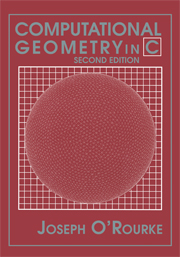5 - Voronoi Diagrams
Published online by Cambridge University Press: 05 June 2012
Summary
In this chapter we study the Voronoi diagram, a geometric structure second in importance only to the convex hull. In a sense a Voronoi diagram records everything one would ever want to know about proximity to a set of points (or more general objects). And often one does want to know detail about proximity: Who is closest to whom? who is furthest? and so on. The concept is more than a century old, discussed in 1850 by Dirichlet and in a 1908 paper of Voronoi.
We will start with a series of examples to motivate the discussion and then plunge into the details of the rich structure of the Voronoi diagram (in Sections 5.2 and 5.3). It is necessary to become intimately familiar with these details before algorithms can be appreciated (in Section 5.4). Finally we will reveal the beautiful connection between Voronoi diagrams and convex hulls in Section 5.7. This chapter includes only two short pieces of code, to construct the dual of the Voronoi diagram (the Delaunay triangulation), in Section 5.7.4.
APPLICATIONS: PREVIEW
1. Fire Observation Towers
Imagine a vast forest containing a number of fire observation towers. Each ranger is responsible for extinguishing any fire closer to her tower than to any other tower. The set of all trees for which a particular ranger is responsible constitutes the “Voronoi polygon” associated with her tower. The Voronoi diagram maps out the lines between these areas of responsibility: the spots in the forest that are equidistant from two or more towers. (A look ahead to Figure 5.5 may aid intuition.)
2. […]
Information
- Type
- Chapter
- Information
- Computational Geometry in C , pp. 155 - 192Publisher: Cambridge University PressPrint publication year: 1998
Accessibility standard: Unknown
Why this information is here
This section outlines the accessibility features of this content - including support for screen readers, full keyboard navigation and high-contrast display options. This may not be relevant for you.Accessibility Information
- 4
- Cited by
